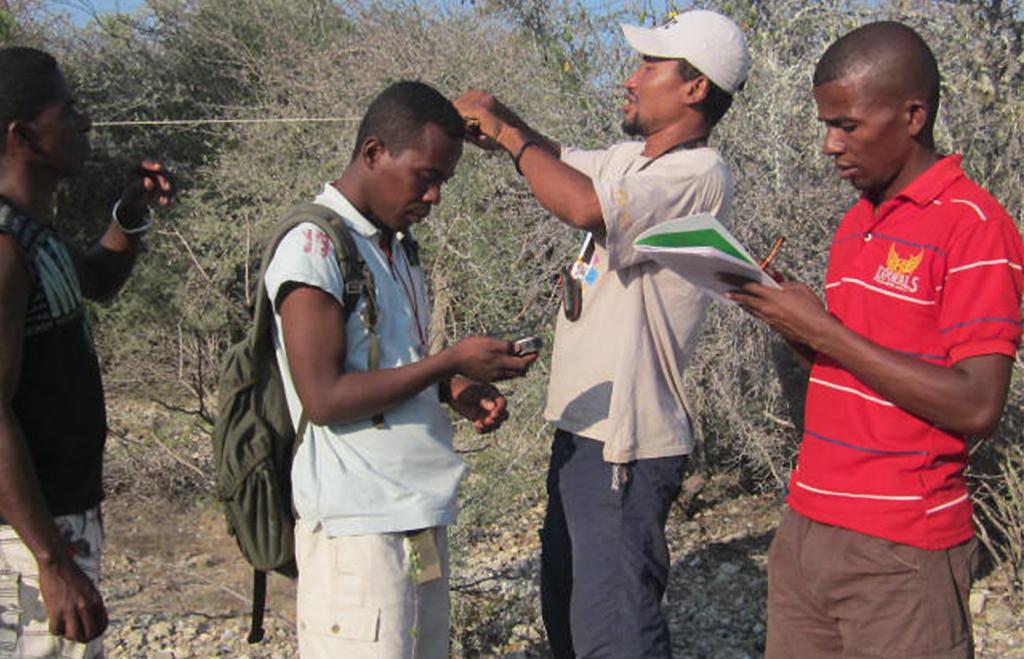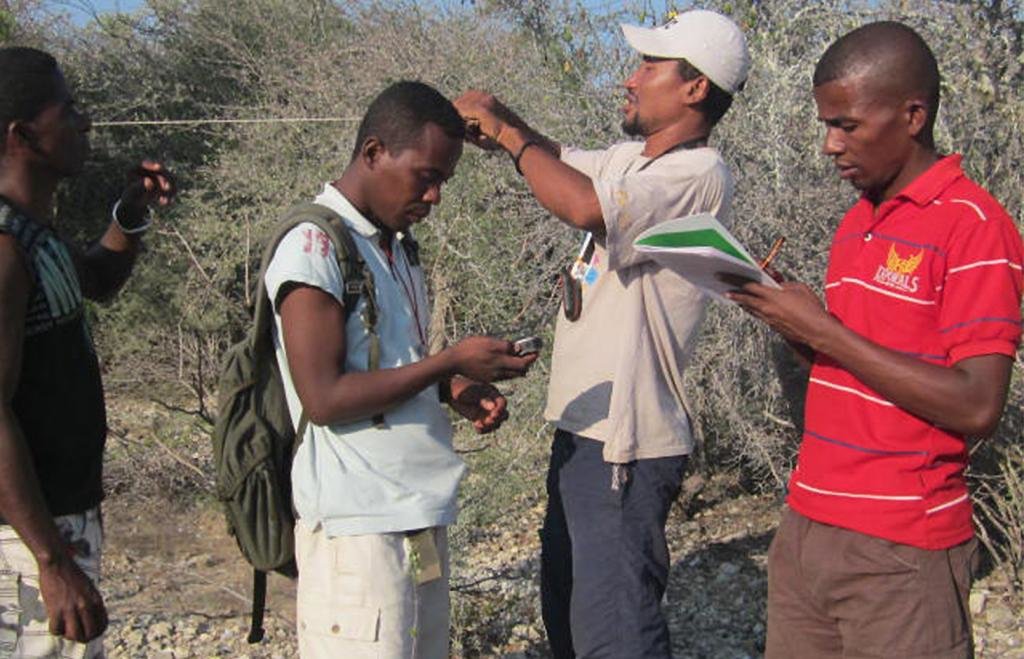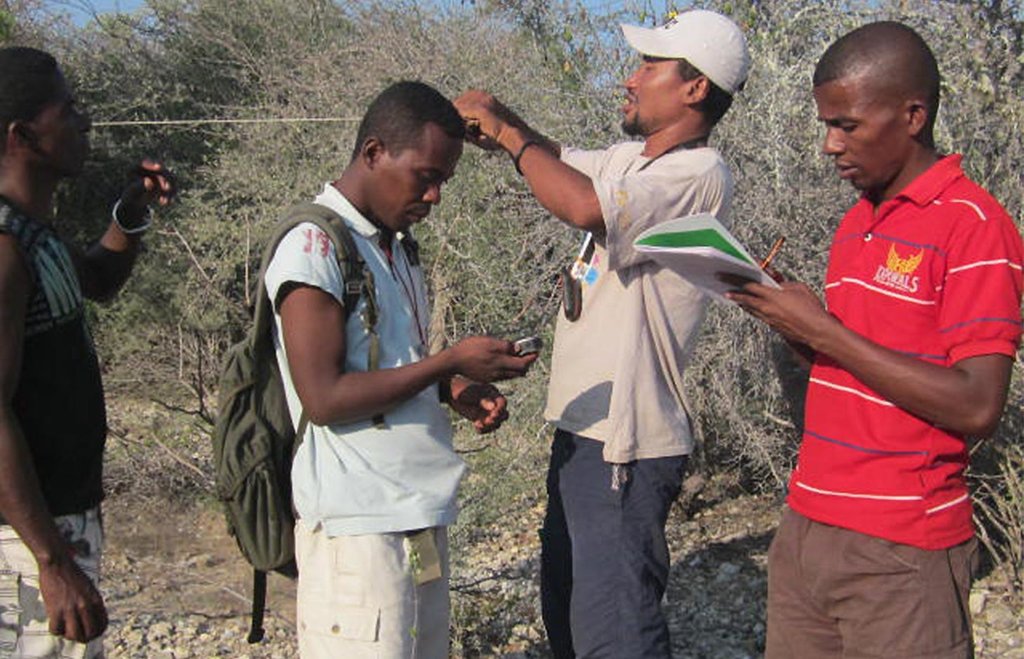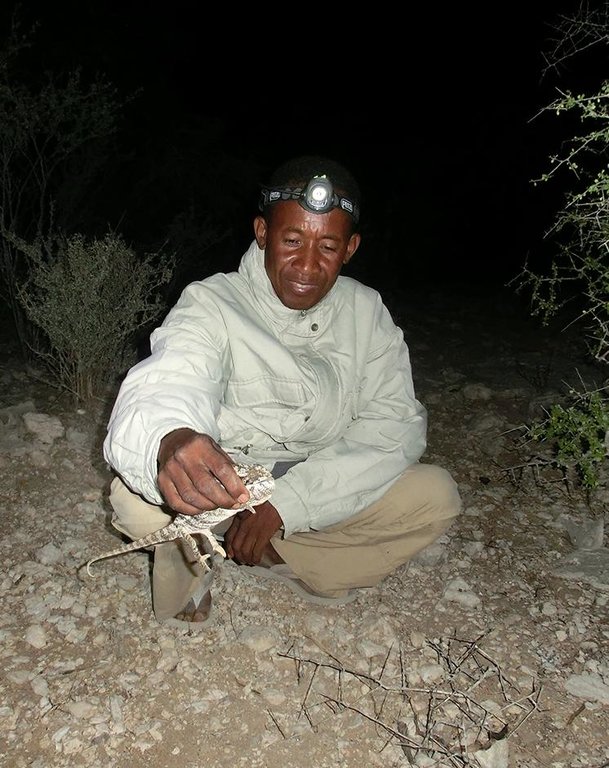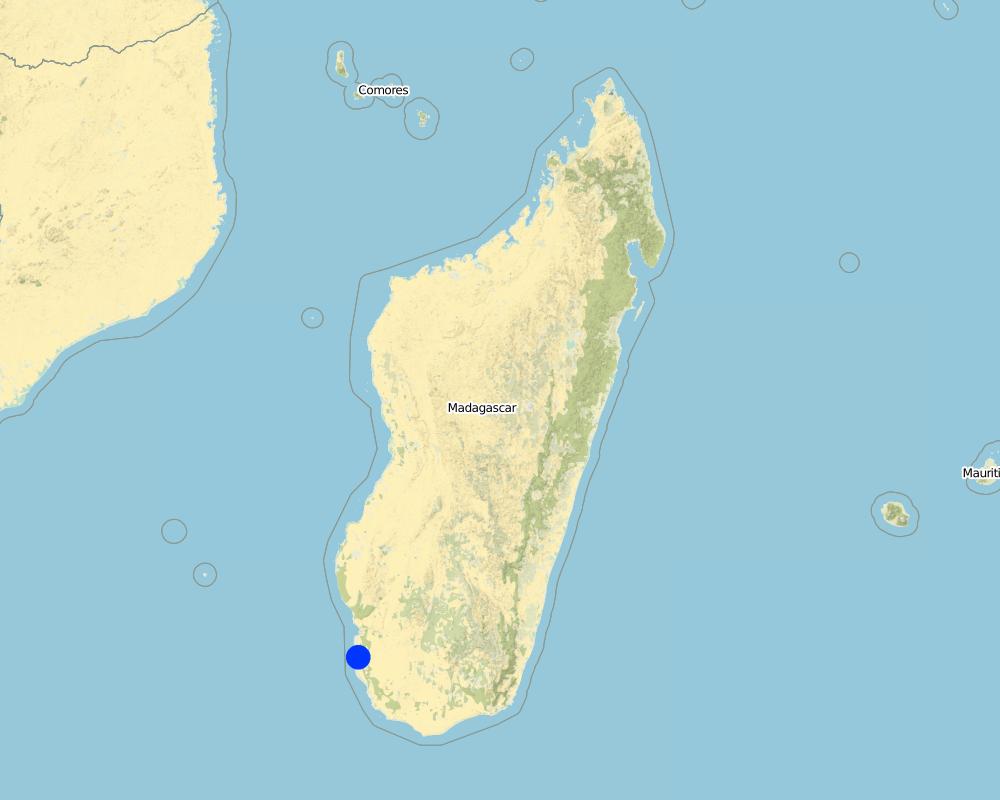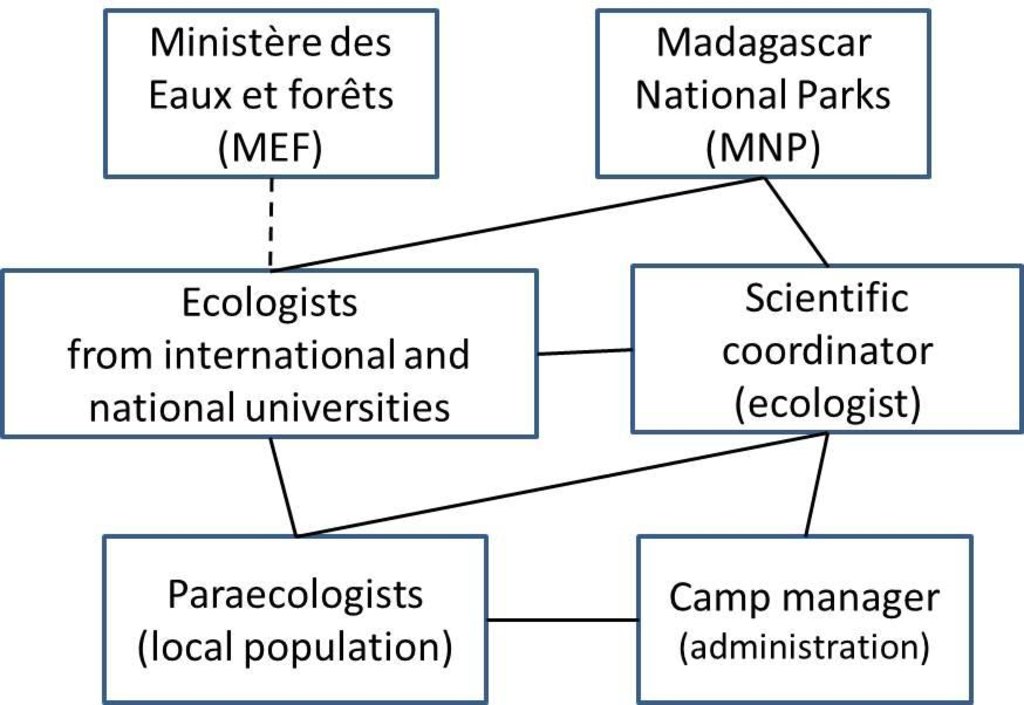Participatory monitoring and evaluation of long-term changes in ecosystems [ប្រទេសម៉ាដាហ្គាស្កា]
- ការបង្កើត៖
- បច្ចុប្បន្នភាព
- អ្នកចងក្រង៖ Joachim Nopper
- អ្នកកែសម្រួល៖ –
- អ្នកត្រួតពិនិត្យច្រើនទៀត៖ Fabian Ottiger, Deborah Niggli
approaches_2610 - ប្រទេសម៉ាដាហ្គាស្កា
ពិនិត្យមើលគ្រប់ផ្នែក
ពង្រីកមើលទាំងអស់ បង្រួមទាំងអស់1. ព័ត៌មានទូទៅ
1.2 ព័ត៌មានលម្អិតពីបុគ្គលសំខាន់ៗ និងស្ថាប័នដែលចូលរួមក្នុងការវាយតម្លៃ និងចងក្រងឯកសារនៃវិធីសាស្ត្រផ្សព្វផ្សាយ
អ្នកជំនាញឯកទេស SLM:
Ratovonamana Yedidya R.
Université d'Antananarivo
ប្រទេសម៉ាដាហ្គាស្កា
អ្នកជំនាញឯកទេស SLM:
Ganzhorn Jörg U.
Universität Hamburg
ប្រទេសអាល្លឺម៉ង់
ឈ្មោះគម្រោងដែលបានចងក្រងឯកសារ/ វាយតម្លៃលើវិធីសាស្ត្រផ្សព្វផ្សាយ (បើទាក់ទង)
Sustainable Landmanagement in south-western Madagascar (SuLaMa / GLUES)ឈ្មោះគម្រោងដែលបានចងក្រងឯកសារ/ វាយតម្លៃលើវិធីសាស្ត្រផ្សព្វផ្សាយ (បើទាក់ទង)
Book project: Making sense of research for sustainable land management (GLUES)ឈ្មោះអង្គភាពមួយ (ច្រើន) ដែលបានចងក្រងឯកសារ/ វាយតម្លៃលើវិធីសាស្ត្រផ្សព្វផ្សាយ (បើទាក់ទង)
Universität Hamburg (UHH) - ប្រទេសអាល្លឺម៉ង់ឈ្មោះអង្គភាពមួយ (ច្រើន) ដែលបានចងក្រងឯកសារ/ វាយតម្លៃលើវិធីសាស្ត្រផ្សព្វផ្សាយ (បើទាក់ទង)
University of Antananarivo - ប្រទេសម៉ាដាហ្គាស្កា1.3 លក្ខខណ្ឌទាក់ទងទៅនឹងការប្រើប្រាស់ទិន្នន័យដែលបានចងក្រងតាមរយៈវ៉ូខេត
តើពេលណាដែលទិន្នន័យបានចងក្រង (នៅទីវាល)?
11/04/2016
អ្នកចងក្រង និង(បុគ្គលសំខាន់ៗ)យល់ព្រមទទួលយកនូវលក្ខខណ្ឌនានាទាក់ទងទៅនឹងការប្រើប្រាស់ទិន្នន័យដែលបានចងក្រងតាមរយៈ វ៉ូខេត:
បាទ/ចា៎
2. ការពណ៌នាអំពីវិធីសាស្ត្រផ្សព្វផ្សាយ SLM
2.1 ពណ៌នាសង្ខេបខ្លីពីវិធីសាស្ត្រផ្សព្វផ្សាយ
Establishing a knowledge base and communication platform in collaboration with para-ecologists for monitoring changes in ecosystems, to aid decision-making in forest management.
2.2 ពណ៌នាលម្អិតពិវិធីសាស្ត្រផ្សព្វផ្សាយ
ពណ៌នាលម្អិតពិវិធីសាស្ត្រផ្សព្វផ្សាយ:
Aims / objectives: This approach strengthens knowledge about the response of biodiversity to environmental changes – namely land conversion, climate change induced impacts and climate-related extreme events, such as droughts and cyclones. Information generated can be used to inform regional authorities. They are then able to adapt management to current conditions, in order to better preserve biodiversity within the National Park. An important component of this approach is the integration of people from the local population as 'para-ecologists' who are trained in survey techniques for biodiversity monitoring. They directly observe changes in biodiversity, and share their knowledge with others in the area. The approach, thus, includes the sensitization of the local population to impacts of environmental change on biodiversity.
Methods: Under this approach, local assistants were trained in biodiversity monitoring techniques by researchers during their regular research activities. Part of the process comprised skills in species identification. Because the researchers had a limited period available for field work, training of these para-ecologists was a pre-requisite for implementation of long-term monitoring activities based on surveying at regular intervals. The surveys initiated by the researchers were plant phenology monitoring, regular capture, marking and recapture of Galidictis grandidieri (the giant striped mongoose) which is a flagship species in the Tsimanampesotse National Park, as well as reptile occurrence monitoring along transects. Monitoring procedures were established, and then continued by para-ecologists under the guidance of a Malagasy researcher who is familiar with ecological field work and acted as a ‘scientific coordinator’. The task of the scientific coordinator was data control and storage, planning of monitoring activities, as well as communication between national authorities, ecologists and para-ecologists. All survey data are available for scientific purposes and can be used to inform Malagasy authorities, or can be directly demanded by Malagasy authorities.
Stages of implementation: A basic research camp for monitoring was established within the Tsimanampesotse National Park in collaboration with Madagascar National Parks and WWF Toliara with third party funding. Four para-ecologists, two cooks and a guard constitute the team. The camp is maintained by a manager who is responsible for maintenance of buildings and electric facilities as well as provision of food. Surveying equipment is stored at the base camp. Computers and other necessary equipment were provided under the SuLaMa project. There are two para-ecologists trained on flora and a further two on fauna. Survey sites for monitoring of animal diversity and plant phenology were established by plant and animal ecologists in cooperation with the para-ecologists. Infrastructure for data acquisition and storage was established. This included the installation of electrical facilities as well as the provisioning of field books and computers. Technicians received language courses and learned computer operation. Regular exchange between the research camp and the national park authority, MNP, was established through a permanently employed scientific coordinator. This exercise resulted in a first workshop on survey techniques, in which staff of Madagascar National Park learned from researchers and para-ecologists.
Role of stakeholders: All survey data are available for scientific purposes and can be used to inform Malagasy authorities, or can be directly demanded from Malagasy authorities.
2.3 រូបភាពនៃវិធីសាស្ត្រផ្សព្វផ្សាយ
2.5 ប្រទេស/តំបន់/ទីតាំងកន្លែង ដែលវិធីសាស្ត្រផ្សព្វផ្សាយត្រូវបានអនុវត្តន៍
ប្រទេស:
ប្រទេសម៉ាដាហ្គាស្កា
តំបន់/រដ្ឋ/ខេត្ត:
Atsimo-Andrefana (South-West Madagascar)
បញ្ជាក់បន្ថែមពីលក្ខណៈនៃទីតាំង:
Beheloke
Map
×2.6 កាលបរិច្ឆេទនៃការចាប់ផ្តើម និងបញ្ចប់នៃវិធីសាស្រ្តផ្សព្វផ្សាយនេះ
សូមបញ្ជាក់ឆ្នាំដែលបានបង្កើតឡើង:
2011
ឆ្នាំបញ្ចប់ (ប្រសិនបើវិធីសាស្ត្រផ្សព្វផ្សាយត្រូវបានឈប់ប្រើប្រាស់):
2016
2.7 ប្រភេទនៃវិធីសាស្ត្រផ្សព្វផ្សាយ
- ផ្អែកលើគម្រោង/កម្មវិធី
2.8 គោលបំណង/ទិសដៅសំខាន់នៃវិធីសាស្ត្រផ្សព្វផ្សាយ
The Approach focused mainly on SLM with other activities (raising environmental awareness, environmental education)
Collect data on biodiversity to increase understanding of environmental change impacts. Use of this data to inform conservation managers. Involve the local population in this process to raise awareness and create ownership.
The SLM Approach addressed the following problems: Lack of knowledge about the changes in biodiversity within the national park; inadequate expertise in animal and plant identification; lack of knowledge about standardized sampling methods; data storage and dissemination not established.
2.9 លក្ខខណ្ឌអនុញ្ញាត ឬរារាំងការអនុវត្តន៍បច្ចេកទេសដែលស្ថិតនៅក្រោមវិធីសាស្រ្តផ្សព្វផ្សាយ
សង្គម/វប្បធម៌/ និងតម្លៃនៃសាសនា
- រារាំង
language barrier
Treatment through the SLM Approach: employment of a French teacher
ចំណេះដឹងស្តីពី SLM និងការទទួលបានការគាំទ្រផ្នែកបច្ចេកទេស
- រារាំង
No housing and facilities for para-ecologists, no infrastructure for data entry and storage as well as storage of equipment
Treatment through the SLM Approach: Establishment of a research camp as the base for all monitoring activities; Establishment of a database for storage of survey data. Keeping of a copy by the scientific coordinator who is able to distribute the data to researchers.
ទំហំការងារ ភាពអាចរកបាននៃកម្លាំងពលកម្ម
- រារាំង
Due to different reasons surveys were occasionally cancelled.
Treatment through the SLM Approach: Data quality of monitoring programs suffers if
surveys are not conducted at regular intervals. To avoid the cancellation of surveys, two persons were trained in the same survey techniques, so that a replacement is available. Nevertheless, occasional cancellations could not be avoided.
3. ការចូលរួម និងតួនាទីរបស់ភាគីពាក់ព័ន្ធ
3.1 អ្នកពាក់ព័ន្ធដែលបានចូលរួមក្នុងវិធីសាស្ត្រផ្សព្វផ្សាយ និងតួនាទីរបស់ពួកគេ
- អ្នកប្រើប្រាស់ដីក្នុងតំបន់/សហគមន៍
members of local population that gain knowledge on biodiversity
- អ្នកស្រាវជ្រាវ
Para-ecologists are all men. Camp staff are equally divided between women and men. No woman occupied a top position however.
- អង្គការក្រៅរដ្ឋាភិបាល
MNP, WWF
- រដ្ឋាភិបាលថ្នាក់ជាតិ (អ្នករៀបចំផែនការ អ្នកសម្រេចចិត្ត)
MEEF
access to monitoring data and knowledge on status of biodiversity conservation effectiveness.
- អង្គការអន្តរជាតិ
BMBF
ប្រសិនមានភាគីពាក់ព័ន្ធច្រើនចូលរួមសូមចង្អុលបង្ហាញភ្នាក់ងារដែលនាំមុខគេ:
Researchers from different disciplines were involved. Scientific coordination was conducted by a Malagasy botanist.
3.2 ការចូលរួមរបស់អ្នកប្រើប្រាស់ដីក្នុងតំបន់/ សហគមន៍ក្នុងតំបន់ក្នុងដំណាក់កាលផ្សេងគ្នានៃវិធីសាស្រ្តផ្សព្វផ្សាយ
| ការចូលរួមរបស់អ្នកប្រើប្រាស់ដីក្នុងតំបន់/សហគមន៍ក្នុងតំបន់ | សូមបញ្ជាក់នរណាត្រូវបានចូលរួម ព្រមទាំងពណ៌នាសកម្មភាពទាំងនោះ | |
|---|---|---|
| ការចាប់ផ្តើម/ការលើកទឹកចិត្ត | ការគាំទ្រពីខាងក្រៅ | Training, identification of places for monitoring activities |
| ការរៀបចំផែនការ | គ្មាន | |
| ការអនុវត្តន៍ | ការគាំទ្រពីខាងក្រៅ | Monitoring within the National Park, giving results of research to National Park staff |
| ការត្រួតពិនិត្យ និងវាយតម្លៃ | គ្មាន | |
| Research | គ្មាន |
3.3 គំនូសបំព្រួញ (ប្រសិនបើមាន)
ការពណ៌នា:
Key partners for a biodiversity monitoring programme in southwestern
Madagascar. Collaborative research is focussed in and around Tsimanampesotse National Park. Ecologists train para-ecologists and develop long term monitoring programs. Scientific coordinator collects data and communicates results to MNP. Para-ecologists conduct surveys, a camp manager ensures research equipment is available and coordinates maintenance.
3.4 ការសម្រេចចិត្តលើការជ្រើសរើសបច្ចេកទេស SLM
តើការសម្រេចចិត្តក្នុងការជ្រើសរើសបច្ចេកទេស(ច្រើន)ត្រូវបានធ្វើឡើងយ៉ាងដូចម្តេច?
- by researchers
ចូរពន្យល់:
Decisions on the method of implementing the SLM Technology were made by by reasearchers. n/a
4. ជំនួយបច្ចេកទេស ការកសាងសមត្ថភាព និងការគ្រប់គ្រងចំណេះដឹង
4.1 ការកសាងសមត្ថភាព/ បណ្តុះបណ្តាល
តើវគ្គបណ្តុះបណ្តាលបានផ្តល់ឱ្យអ្នកប្រើប្រាស់ដី/អ្នកពាក់ព័ន្ធផ្សេងៗទៀតដែរឬទេ?
បាទ/ចា៎
- local population
ប្រធានបទបណ្តុះបណ្តាល:
Local men who were trained in animal and plant identification and survey techniques. They became specialists in their area of work and due to regular surveys, better understand the effects of environmental changes on plant phenology and the occurrence and behaviour of animals. They share their knowledge in their villages, thus contributing to raising awareness about the environment.
4.2 សេវាផ្តល់ប្រឹក្សាយោបល់
តើអ្នកប្រើប្រាស់ដីបានទទួលនូវសេវាផ្តល់ប្រឹក្សាដែរ ឬទេ?
បាទ/ចា៎
ពណ៌នា/ពន្យល់:
Advisory service is inadequate to ensure the continuation of land conservation activities
4.3 ការពង្រឹងសមត្ថភាពស្ថាប័ន (ការអភិរឌ្ឍន៍អង្គភាព)
តើស្ថាប័នទាំងអស់ត្រូវបានបង្កើតឡើង ឬពង្រឹងសមត្ថភាពតាមរយៈវិធីសាស្ត្រផ្សព្វផ្សាយដែរ ឬទេ?
- ទេ
4.4 ការត្រួតពិនិត្យ និងវាយតម្លៃ
តើការត្រួតពិនិត្យ និងវាយតម្លៃគឺជាផ្នែកមួយនៃវិធីសាស្ត្រដែរឬទេ?
បាទ/ចា៎
មតិយោបល់:
technical aspects were ad hoc monitored by government through observations; indicators: data collection by paraecologists was observed by researchers during training phase
Control of data quality aspects were ad hoc monitored by project staff through observations
Regular data collection aspects were regular monitored by project staff through
There were no changes in the Approach as a result of monitoring and evaluation
There were no changes in the Technology as a result of monitoring and evaluation: n/a
4.5 ការស្រាវជ្រាវ
តើការស្រាវជ្រាវ គឺជាផ្នែកមួយនៃវិធីសាស្រ្តដែរឬទេ?
បាទ/ចា៎
បញ្ជាក់ប្រធានបទ:
- បរិស្ថានវិទ្យា
សូមផ្តល់ព័ត៌មានបន្ថែមទៀតឱ្យបានលម្អិត និងចង្អុលបង្ហាញនរណាដែលបានធ្វើការស្រាវជ្រាវ:
Research was exclusively undertaken within the national park. Extension of research activities into non-protected areas is aspired in collaboration with the local communities.
Research was carried out on station
5. ថវិកា និងសម្ភារៈឧបត្ថម្ភពីខាងក្រៅ
5.1 ថវិកាប្រចាំឆ្នាំសម្រាប់ផ្សព្វផ្សាយ SLM
ប្រសិនបើចំនួនពិតប្រាកដនៃថវិកាប្រចាំឆ្នាំមិនត្រូវបានដឹងច្បាស់ សូមប្រាប់ពីចន្លោះនៃថវិកានោះ:
- 10,000-100,000
មតិយោបល់ (ឧ. ប្រភពសំខាន់នៃមូលនិធិ/ម្ចាស់ជំនួយចំបង):
Approach costs were met by the following donors: international (German Ministry of Education and Research, BMBF): 100.0%
5.2 ការគាំទ្រផ្នែកហិរញ្ញវត្ថុ / សម្ភារៈដែលបានផ្តល់ទៅឱ្យអ្នកប្រើប្រាស់ដី
តើអ្នកប្រើប្រាស់ដីបានទទួលការគាំទ្រផ្នែកហិរញ្ញវត្ថ/សម្ភារៈសម្រាប់ការអនុវត្តន៍បច្ចេកទេសដែរឬទេ:
បាទ/ចា៎
5.3 សូមបញ្ជាក់ពីធាតុចូលត្រូវបានផ្តល់បដិភាគ (រួមទាំងកម្លាំងពលកម្ម)
- សម្ភារៈ
| សូមបញ្ជាក់ ធាតុចូលណាខ្លះដែលបានផ្តល់បដិភាគ | កម្រិតទំហំប៉ុណ្ណា | សូមបញ្ជាក់ពីការបដិភាគ |
|---|---|---|
| electric facilities and research equipment | ផ្តល់ហិរញ្ញវត្ថុទាំងស្រុង | |
- ការសាងសង
| សូមបញ្ជាក់ ធាតុចូលណាខ្លះដែលបានផ្តល់បដិភាគ | កម្រិតទំហំប៉ុណ្ណា | សូមបញ្ជាក់ពីការបដិភាគ |
|---|---|---|
| construction & maintenance of research camp | ផ្តល់ហិរញ្ញវត្ថុទាំងស្រុង | |
- ហេដ្ឋារចនាសម្ព័ន្ធ
| សូមបញ្ជាក់ ធាតុចូលណាខ្លះដែលបានផ្តល់បដិភាគ | កម្រិតទំហំប៉ុណ្ណា | សូមបញ្ជាក់ពីការបដិភាគ |
|---|---|---|
| cart | ផ្តល់ហិរញ្ញវត្ថុទាំងស្រុង | |
ប្រសិនបើកម្លាំងពលកម្មធ្វើដោយអ្នកប្រើប្រាស់ដី តើវាជាធាតុចូលដ៏សំខាន់មួយដែរ ឬទេ:
- បង់ជាសាច់ប្រាក់
មតិយោបល់:
Monthly salary for para-ecologists, as well as staff of research camp.
Research equipment included among others Computers, torches, GPS units, cameras. A cart was needed to transport persons and material.
5.4 ឥណទាន
តើឥណទានដែលបានផ្តល់នៅក្រោមវិធីសាស្ត្រផ្សព្វផ្សាយសម្រាប់សកម្មភាព SLM នេះយ៉ាងដូចម្តេច?
ទេ
6. ការវិភាគរកផលប៉ះពាល់ និងសេចក្តីសន្និដ្ឋាន
6.1 ផលប៉ះពាល់នៃវិធីសាស្ត្រផ្សព្វផ្សាយ
តើវិធីសាស្ត្រផ្សព្វផ្សាយជួយអ្នកប្រើប្រាស់ដីដើម្បីអនុវត្តន៍ និងថែទាំបច្ចេកទេស SLM?
- ទេ
- បាទ/ច៎ា បន្តិចបន្តួច
- បាទ/ច៎ា ជាមធ្យម
- បាទ/ច៎ា បានខ្លាំង
This approach is to evaluate long-term impacts of land conversions, gradual climate change and climate-related extremes (disasters) on biodiversity. Due to insufficient data because of the short time since implementation, impacts have not yet been assessed.
តើវិធីសាស្ត្រផ្សព្វផ្សាយនេះផ្តល់សិទ្ធិអំណាចដល់សង្គមនិងសេដ្ឋកិច្ចដែលក្រុមមិនទទួលបានផលប្រយោជន៍?
- ទេ
- បាទ/ច៎ា បន្តិចបន្តួច
- បាទ/ច៎ា ជាមធ្យម
- បាទ/ច៎ា បានខ្លាំង
By providing employment for some local people.
Did other land users / projects adopt the Approach?
- ទេ
- បាទ/ច៎ា បន្តិចបន្តួច
- បាទ/ច៎ា ជាមធ្យម
- បាទ/ច៎ា បានខ្លាំង
Community-based monitoring is on the rise in Madagascar.
Did the Approach lead to improved livelihoods / human well-being?
- ទេ
- បាទ/ច៎ា បន្តិចបន្តួច
- បាទ/ច៎ា ជាមធ្យម
- បាទ/ច៎ា បានខ្លាំង
Para-ecologist and associated staff of the research camp were continuously employed; a job opportunity that is rarely encountered within the study region. Awareness of the value of biodiversity has been raised.
Did the Approach help to alleviate poverty?
- ទេ
- បាទ/ច៎ា បន្តិចបន្តួច
- បាទ/ច៎ា ជាមធ្យម
- បាទ/ច៎ា បានខ្លាំង
By providing employment for some local people.
6.2 ការលើកទឹកចិត្តចម្បងៗរបស់អ្នកប្រើប្រាស់ដីសម្រាប់ការអនុវត្តបច្ចេកទេស SLM
- ការចំណាយ/បដិភាគ
employment
- well-being and livelihoods improvement
regular salaries
6.3 សកម្មភាពផ្សព្វផ្សាយដែលប្រកបដោយចីរភាព
តើអ្នកប្រើប្រាស់ដីអាចធ្វើឱ្យមានចីរភាពនូវអ្វីដែលត្រូវបានអនុវត្តន៍តាមរយៈវិធីសាស្ត្រផ្សព្វផ្សាយដែរឬទេ(ដោយពុំមានការគាំទ្រពីអ្នកខាងក្រៅ)?
- ទេ
ប្រសិន ទេ ឬមិនប្រាកដសូមបញ្ជាក់ និងពន្យល់:
Data collection by members of the local population is only valuable if data are subsequently quality-assured, analysed and evaluated. Thus without support from researchers this approach is of no value.
6.4 ភាពខ្លាំង/ គុណសម្បត្តិនៃវិធីសាស្ត្រផ្សព្វផ្សាយ
| ភាពខ្លាំង/ គុណសម្បត្តិ/ ឱកាស ទស្សនៈរបស់បុគ្គលសំខាន់ៗ |
|---|
| By employing people from villages surrounding the national Park in regular research activities as well as biodiversity monitoring, knowledge on dynamics of natural systems is experienced firsthand and can be transmitted to other members of the local population. This can be seen as an informal knowledge hub from which communities learn more about the ecosystem they live in. (How to sustain/ enhance this strength: Creating owenership might lead to a more sustainable resource use practice.) |
| Collecting data and knowledge to support evidence based decision making for biodiversity conservation (How to sustain/ enhance this strength: Maintain and carry forward the knowledge base and communication platform by ensuring funding ) |
6.5 ភាពខ្សោយ/ គុណវិបត្តិនៃវិធីសាស្ត្រ និងរកដំណោះស្រាយ
| ភាពខ្សោយ/ គុណវិបត្តិ/ ហានិភ័យក្នុងទស្សនៈរបស់បុគ្គលសំខាន់ៗ | តើបច្ចេកទេសទាំងនោះបានដោះស្រាយបញ្ហាដូចម្តេច? |
|---|---|
| Monitoring activities depend on continuous funding. Funding was provided by SuLaMa/BMBF. Efforts for a continuation of funding need to be undertaken throughout project implementation as well as after project has terminated. | The situation could be stabilized by mainstreaming monitoring activities in programs of in-country authorities, which is planned but has not yet been implemented. |
7. ឯកសារយោង និងវេបសាយ
7.1 វិធីសាស្ត្រ/ ប្រភពនៃព័ត៌មាន
- តាមការចុះទីវាល ការស្រាវជ្រាវនៅទីវាល
- ការសម្ភាសន៍ជាមួយអ្នកប្រើប្រាស់ដី
ការតភ្ជាប់ និងម៉ូឌុល
ពង្រីកមើលទាំងអស់ បង្រួមទាំងអស់ការតភ្ជាប់
គ្មានការតភ្ជាប់
ម៉ូឌុល
គ្មានម៉ូឌុល


